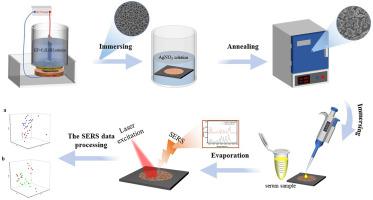Analytica Chimica Acta ( IF 6.2 ) Pub Date : 2023-03-17 , DOI: 10.1016/j.aca.2023.341116 Shibin Han 1 , Cheng Chen 2 , Chen Chen 3 , Lijun Wu 4 , Xue Wu 4 , Chen Lu 5 , Xueqin Zhang 4 , Peng Chao 4 , Xiaoyi Lv 6 , Zhenhong Jia 7 , Junwei Hou 8

|
Ag2O–Ag-porous silicon Bragg mirror (PSB) composite SERS substrates were successfully synthesized by using a combination of electrochemical and thermochemical methods. Test results showed that the SERS signal increased and decreased as the annealing temperature used for the substrate increased, where the most intense SERS signal was obtained using a substrate annealed at 300 °C. Stability test results showed substantial enhancement of the SERS signal intensity of the Ag2O-Ag-PSB composite one month after preparation compared with that of conventional Ag-PSB. We conclude that Ag2O nanoshells play an essential role in SERS signal enhancement. Ag2O prevents natural oxidation of Ag nanoparticles (AgNPs) and has a solid localized surface plasmon resonance (LSPR). SERS signal enhancement was tested using this substrate for serum from patients with Sjögren's syndrome (SS) and Diabetic nephropathy (DN), as well as from healthy controls (HC). SERS feature extraction was performed using principal component analysis (PCA). The extracted features were analyzed by a support vector machine (SVM) algorithm. Finally, a rapid screening model for SS and HC, as well as DN and HC, was developed and used to perform controlled experiments. The results showed that the diagnostic accuracy, sensitivity and selectivity for SERS technology combined with machine learning algorithms reached 90.7%, 93.4% and 86.7% for SS/HC and 89.3%, 95.6% and 80% for DN/HC, respectively. The results of this study show that the composite substrate has excellent potential to be developed into a commercially available SERS chip for medical testing.
中文翻译:

将退火银纳米粒子与多孔硅布拉格镜 SERS 基板和机器学习耦合,用于快速无创疾病诊断
结合使用电化学和热化学方法成功合成了Ag 2 O-Ag 多孔硅布拉格镜 (PSB) 复合 SERS 基板。测试结果表明,SERS 信号随着用于基板的退火温度的升高而增加和降低,其中最强烈的 SERS 信号是使用在 300 °C 下退火的基板获得的。稳定性测试结果表明,与传统的Ag-PSB相比, Ag 2 O-Ag-PSB复合材料制备1个月后的SERS信号强度显着增强。我们得出结论,Ag 2 O 纳米壳在 SERS 信号增强中起着重要作用。银2O 可防止 Ag 纳米粒子 (AgNPs) 的自然氧化,并具有固体局部表面等离子体共振 (LSPR)。SERS 信号增强是使用这种底物对来自干燥综合征 (SS) 和糖尿病肾病 (DN) 患者以及健康对照 (HC) 的血清进行测试的。使用主成分分析 (PCA) 执行 SERS 特征提取。提取的特征通过支持向量机(SVM)算法进行分析。最后,开发了 SS 和 HC 以及 DN 和 HC 的快速筛选模型并用于执行对照实验。结果表明,SERS技术结合机器学习算法对SS/HC的诊断准确率、灵敏度和选择性分别达到90.7%、93.4%和86.7%,对DN/HC的诊断准确率、灵敏度和选择性分别达到89.3%、95.6%和80%。


























 京公网安备 11010802027423号
京公网安备 11010802027423号